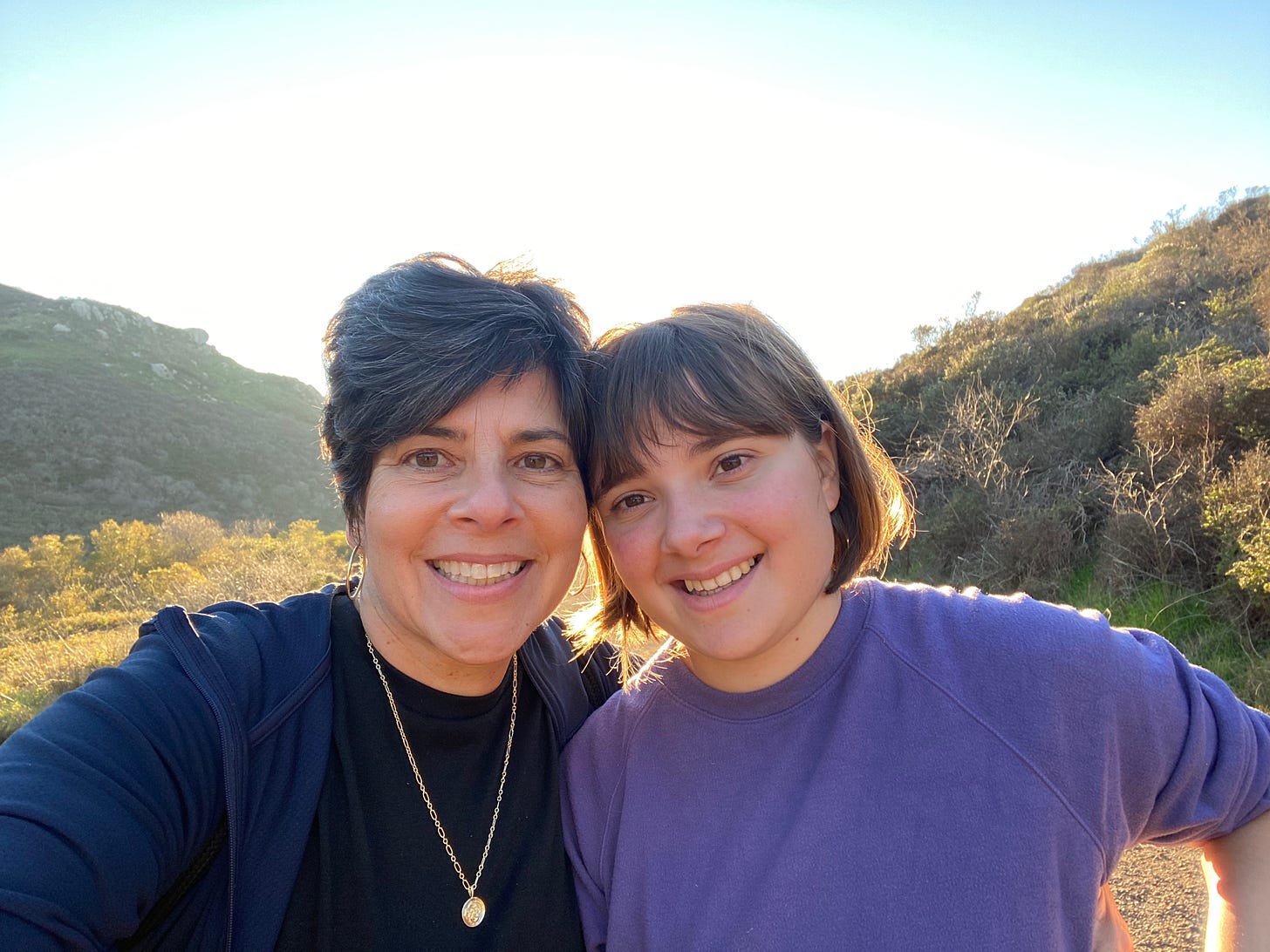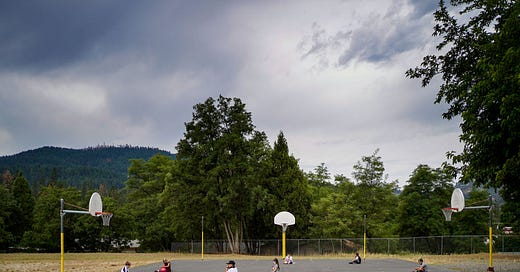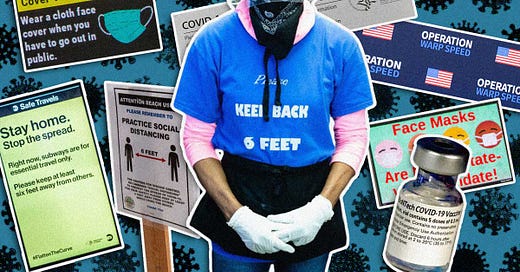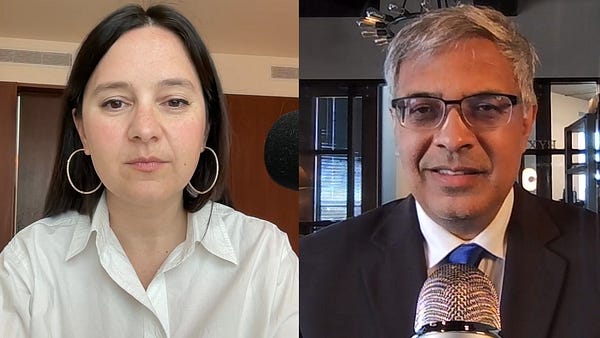
The Free Press

Why, in my now–home state of California, have autism diagnoses increased a stunning 50-fold in the last 33 years? It’s a comment on our times that this crucial medical question has become a fiercely contested political matter. As America’s next presidential campaign gets underway, Robert F. Kennedy Jr. has made a policy centerpiece his belief that childhood vaccines cause autism.
I vehemently disagree with him on this—and challenged his views recently on my podcast. (There is ample evidence of other causes, like parental age, among other factors.)
But as a new mother, I suddenly became aware that other children—the children of my friends—were being diagnosed with autism in burgeoning numbers. Or at least it felt that way. Was it just my imagination?
Today, Jill Escher, the mother of two children profoundly disabled by autism, explains in her powerful, even shocking piece for us, that the rise in autism is very real. And it is not just a matter of better—or broader—diagnosis.
Jill is a former corporate lawyer who gave up her career to take care of and fiercely advocate for her children. That includes what she does in the piece below: explaining to the rest of the world what she, and countless other parents like her, must navigate. Jill believes that almost everything about autism—the way it is discussed, research into its origins, and its potential cures—is filtered through our broken politics, a turn that has caused the field to wither.
And yet, as Jill points out, the numbers of people diagnosed with autism continue to skyrocket. Which means that society must readdress the fundamental questions about why this is happening, and get serious about how to care for this vulnerable population. We are glad to bring you her tough and scrupulous report. —BW
In the summer of 2001 we took our younger son, two-year-old Jonathan, to the neurologist. He hadn’t developed speech, never played with toys, and had a compulsion to stare at cracks in the pavement while flapping his hands. The diagnosis was almost instant: autism. “He has it in spades,” the doctor said.
Autism? We had hardly heard the term growing up, and we had nothing remotely like it up our family trees. My pregnancy was healthy and free from risk factors. Yet here we were, handed a devastating diagnosis, with our son sentenced, for no reason we could discern, to a lifetime of severe mental impairment. And it wasn’t just Jonny. All around us grew a rapidly rising tide of autism. The numbers were surging in the local school districts. The regional developmental disability agency had become overwhelmed with new autism intakes. Serious autism, hard autism—not a sort anyone would have missed before.
When I was pregnant five years later, doctors assured me it was unlikely lightning would strike twice, especially because Jonny’s autism was not caused by some familial genetic defect, but by the time adorable Sophie was 16 months old, the signs were clear. No pointing, no peekaboo, no playing with toys. Like her brother, she met none of her cognitive or language milestones, not even close. Autism, again. In spades.
Today, despite extensive therapies and specialized schooling, both Jonny, 24, and Sophie, 17, remain nonverbal and profoundly disabled by autism. What does that look like? Well, the other day during our daily outing, Jonny found a tube of sunscreen in the car and rubbed it all over his shorts. Not exactly a good look, but undeterred, we entered the boba place for his favorite smoothie. Though I grasped the back of his t-shirt, he bolted out, and it’s beyond my capacity to wrangle the 180 pounds of him back in. Once settled in the car, he bit on an armrest.
Sophie, my cheerful constant companion, has a joyous smile, and unlike Jonny is so highly adaptable that she skis Tahoe’s tallest mountains and will happily chill at any Grateful Dead tribute concert. But like her brother she cannot talk, read, or write, or grasp even the most basic of abstract concepts—not even family or week or birthday. While young ladies her age are applying to college, she’s still not sure how to brush her teeth or put on her socks. Her learning is stuck, Groundhog Day-like, at a toddler level.
Even now nobody can tell us what could possibly have caused these extreme mental disabilities in our children—nor can they, shall I add, in the vast majority of autism cases. It’s not your imagination: the field is stagnating in the wake of wave after wave of unsuccessful attempts to understand the origins of autism, or to alter its trajectory.
The recent rise of the “neurodiversity” identity movement, where autism is reinvented as a natural difference to be celebrated, not investigated, prevented, or treated, has helped spread a fairy dust of complacency over the autism world. While rates continue to climb—to 1 in 36, or nearly 3 percent, of all eight-year-olds by the latest count from the Centers for Disease Control and Prevention (CDC)—the world, except of course for parents like me, seems to be waving a white flag of surrender. It’s become de rigueur to normalize autism rather than treat it as the national emergency it most certainly is.
The examples are everywhere. The leading autism conference, INSAR (International Society for Autism Research), which once focused on serious-minded biological research, has drifted into something of a celebration of neurodiversity. In this reality distortion field, Lee Wachtel, MD, medical director of the Neurobehavioral Unit at Kennedy Krieger Institute in Baltimore, which treats hundreds of autism patients, said to a group of us parents, “I work in a war zone, but here at INSAR you’d think autism was a celebration.”
Journals regularly publish papers by language-policing neurodiversity advocates urging a purge of common and useful terminology like deficit or disorder so as to reduce supposed stigma associated with autism. Even the leading autism journal now suggests authors avoid ordinary terms like disruptive behaviors or challenging behaviors, saying the journal is “decreasing the number of accepted articles focusing solely on weaknesses, problems, and deficits”—even though the Diagnostic and Statistical Manual (DSM) defines autism by its very evident impairments. Apparently we are supposed to see our children, many of whom are among the most critically disabled people on the planet, as disabled only by a society that fails to understand them, and not by any biological deficit.
Worse, meetings of the federal autism advisory committee—the Interagency Autism Coordinating Committee, or IACC—chaired by the National Institute for Mental Health, and authorized by the Autism CARES Act, are notorious for becoming more social justice theater than as fora for addressing urgent questions. The IACC started life as the Combating Autism Act in 2006, but the title changed in 2014 to the Autism CARES Act after proponents crumbled to pressure from neurodiversity advocates.
Now, prevention of autism is pretty much off the table. Issues affecting the most severe cases are largely drowned out, while members of the IACC urge the cleansing of “ableist” language like risk for autism and behaviors. The CARES Act has been so ineffectual in moving the needle on autism it has become a cruel joke in autism circles; a friend called it the “Collapse of Autism Realities Act.”
Meanwhile, disability policies based on fantastical conceptualizations of ability are creating cruel consequences for our most vulnerable. The few jobs that are within the grasp of many adults disabled by autism are under threat of complete elimination. A push to eliminate sub-minimum wage job programs, which offer the only legal avenue to employment for the severely cognitively disabled, means people like my kids will lose their only chance at structured, supported, productive work, and will be pushed even further to the margins of society.
Then, there’s long-term housing. State Medicaid programs are by far the largest source of funds for long-term care for developmentally disabled adults. Those programs promote inclusion for those who can live in ordinary community homes, which is great when it works, but, citing often unrealistic goals of independence and self-determination, can punish new programs needed to serve those who require total, around-the-clock care. Abandonment under the guise of progressive empathy.
And to be fair, part of me gets it. I certainly celebrate the precious people in our autism community and want them to be included, loved, and supported. In my roles at various nonprofits I have supported countless people with autism, organized more than 200 events for people on the autism spectrum (you name it: pool parties, concerts, dances, hikes, picnics, social groups, skating), and have long co-chaired a major conference at Stanford aimed at helping achieve the best quality of life for autistic adults. Who doesn’t want the best for people with autism? We all do.
But our unwavering desire for social good has in too many ways lapsed into sugarcoating and trivializing this serious mental disability and the galactic challenges wrought by its dramatic growth. We’re stuck in the post-truth doldrums, and it’s never been more important to talk frankly and openly about the realities of autism.
Not a superpower
In recent years we have seen autism take on an absurd umbrella aspect that can cover quirky people like Elon Musk, sensitive artists like the singer Sia, and even elite athletes like Tony Snell. Some people, who are so high-functioning I would consider my kids completely cured if they had similar abilities, call their autism a “gift” or even a “superpower.” But for the majority of people with autism, it’s a devastating, or at least extremely life-limiting, disability. You may see The Good Doctor—a drama about a genius surgeon with autism—but you probably don’t see news coverage of adults like P., who must be helmeted to prevent brain injury from constant self-harm, or even my friend Z., who will bounce around a restaurant stealing food from other diners’ plates, or teens like T., who has broken every window in his home, using his head.
Some laudable efforts are creating badly needed clarity about autism subtypes. Notably, a 2021 Lancet Commission paper introduced the term profound autism to refer to those with IQs under 50 or who are nonverbal or minimally verbal, meaning those most severely impacted, those like my kids. It’s a good start—these people obviously need attention to their specific and intensive needs. The CDC recently reported that profound autism represents about 27 percent of all U.S. childhood autism, and, on an absolute level, 0.5 percent of all U.S. children.
But that hardly means the other 73 percent are mildly affected. In the great middle of autism, those with IQs in the 50s, 60s, and even 70s range, and who have some language, are typically very seriously disabled. Take for example my friend K., 24, who loves showing me pictures of his “girlfriend,” a video game character with flaming red hair. My buddy R., 31, has memorized every Disney song ever written and still believes in Santa Claus. The burly D., 28, managed to finish high school but can unexpectedly launch into rages, throwing tables and chairs.
A functional notch above them are guys like S., 30, who could not keep a job for more than a few weeks and ended up back at home, supported by his parents. W., 32, spends his days on video game sites, where he is quite a champ, but is barely able to have an adult-level conversation. A great many “high-functioning” autistics may be lovable and gifted in their own ways, but simply are not mentally equipped to navigate adult life.
And let’s be clear: autism can be so fierce that it is deadly. Each year, dozens of children with autism, with little sense of danger and no common sense, wander from their homes or caregivers and die on roads, or more often, drown in nearby bodies of water. When a midnight fire in 2020 engulfed the home of my closest friend, Feda Almaliti, she ran upstairs into the thick, black smoke to get her 15-year-old son Muhammed to exit. Mu, severely autistic and physically imposing, refused to budge despite her pleas. When the firefighters found their bodies, Feda was embracing Mu.
No, only for the most privileged can autism be called a superpower.
Dysregulated brain development, not vaccines
Though neurodiversity advocates cast autism as a “different way of thinking,” basic research tells another story. The neurobiological roots of autism by and large can be found in abnormalities of early brain development, beginning in the fetal period. Studies, for example, found a derailment in the way a baby’s neurons develop in the early stages of brain formation and how they migrate to their proper positions, particularly in the cerebral cortex, where they should form a specific and lavishly connected layered structure. Though autism may be invisible from an external perspective, and while more waits to be discovered, it is now understood that the disorder is largely rooted in developmental dysregulations that lead to very real microstructural abnormalities and circuitry defects.
Which brings me to presidential candidate Robert F. Kennedy Jr. It always amazes me that the vaccine hypothesis, an idea so devoid of biological plausibility and so debunked by rigorous research, remains popular. In the Twitterverse it seems ascendant once again, perhaps due to the absence of other explanations that could fill the void, and the mistrust that arose over the Covid-19 vaccine mandates and the shots themselves. Many people have explained why childhood immunizations cannot and do not cause autism, and a mountain of studies on many vaccines shows no increased risk for autism. Given my space constraints I won’t repeat the information here. But while the Democratic presidential hopeful may be right to point out the puzzle of the increasing rates of autism (every candidate should acknowledge the autism emergency), he is grotesquely unscientific and irresponsible in pointing to vaccines as a culprit.
In plain terms, autism is a brain organization disorder, though its manifestations may not appear until certain behavioral milestones are expected, or until the dynamic processes of infant brain development reach a certain point. With some exceptions, it is present at birth, but not identified until later.
With my kids, in retrospect, signs could be seen in their early months: their low responsiveness to external stimuli, their lack of curiosity and playfulness. While RFK Jr. and others sow doubt about childhood vaccines, the obvious truth is they are a great triumph of modern medicine that protect our children from devastating diseases that can cause, among other things, brain damage and severe impairment.
A true, staggering increase in autism
Perhaps the biggest debate in autism now is around the dramatically increasing rates. Is it real or just an artifact of relabeling? Recently we’ve seen harden into dogma a formerly soft speculation that mere awareness has fueled the soaring numbers, as though we are just pathologizing behavior that somehow went unnoticed before.
I understand that we all have a certain amount of catastrophe fatigue, and if we have a choice not to believe that neurodevelopmental abnormality is afflicting an ever-increasing portion of our children, we might make that choice. But unfortunately, the empirical evidence for truly soaring autism rates, based on objective measures, is simply overwhelming. The sweeping upward curves over the past 20–30 years can be seen in almost all sectors—our state developmental disability systems, our schools, our medical providers, our Medicaid and Social Security systems—even when the definition of autism was held constant. Similar growth is seen in Canada, England, Northern Ireland, and other countries.
My state, California, is well known for keeping the best autism data in the nation, owing to its decades-old mandate to find and serve residents with developmental disabilities. The numbers are conscience-shocking and not remotely subtle. We have seen the autism caseload in our Department of Developmental Services (DDS)—which serves only substantially disabling autism that meets the definition of developmental disability, and not the full spectrum—soar from 3,262 in 1989 to more than 160,000 in 2022. That’s a 50-fold increase over 33 years.
Childhood data from earlier generations show that autism barely registered as a blip. For example, a massive and landmark study of children born from 1958–1965 found the rate of autism in seven-year-old children to be 0.0466 percent, or 0.066 percent when using a broader definition, with IQs reaching up to 82. Compare that to the CDC’s walloping finding that today, 0.5 percent of U.S. children have profound autism with IQs under 50, or who are nonverbal or minimally verbal.
CDC data also show that over just 12 years, from 2008 to 2020, autism increased across all categories of intellectual functioning. For cases with intellectual disability (IQ 70 and under), the prevalence more than doubled from 0.429 percent to 1.046 percent. School districts around the country have long sounded the alarm about the increasing cases of schoolchildren with autism in need of special education services. These aren’t just quirky kids, but kids who could not succeed in mainstream education. Even as the Los Angeles Unified School District experienced declining overall enrollment, its special education autism numbers surged sixfold over 20 years, from 2,784 in 2001 to 17,217 in 2021.
Walter Zahorodny, PhD, associate professor of pediatrics at Rutgers and director of the New Jersey Autism Study, who has studied many cohorts over more than two decades, summed it up with me this way: “Autism prevalence has increased significantly and broadly across every group, type, and category across U.S. regions since 2000. The surge in autism cannot be explained by broadening of criteria, diagnostic substitution, or other rationalizations reflecting the hypothesis of better awareness.”
What’s driving the increase in autism?
The skyrocketing numbers, of course, raise the question: why? For decades, researchers have scoured both genes and environment, and for the most part we still don’t understand it. While it’s become popular to say “autism is genetic,” that’s a radical mischaracterization of what the research actually shows. Intensive studies from large cohorts have seen that about 14 percent of cases can be attributed to rare genetic defects. And none of these genetic cases are “autism” per se; often they are syndromes where autism may be a feature, as with Fragile X or Phelan-McDermid syndrome.
What fuels the “genetics” narrative is not wild success in gene-finding, but rather repeated studies showing that autism is highly heritable—not down the ancestral line, mind you, but heritable among a horizontal generation, based mainly on twin studies and a high recurrence risk among siblings. The failure to understand the forces behind this recurrence in autism families (just like mine) has been termed the “missing heritability” of autism. This has led to speculation that perhaps the bulk of autism could be explained by normally harmless common genetic variants somehow acting together to influence risk. However, early studies probing this hypothesis have come up with little to support that idea.
What about the environment? Studies have found few external factors that notably raise autism risk, but there are some, such as premature birth, maternal use of some drugs and medications, maternal infection, and neonatal hypoxia. Advanced age of the father, and to some degree, the mother, is associated with increased risk, but this cannot explain more than a small fraction of cases. There is weak evidence only for so-called nonheritable factors raising risk for autism.
With so little to show after decades of research, the mood is certainly one of shoulder-shrugging resignation. Autism Speaks, an entity once fervently devoted to the question of autism causation, has eliminated from its mission any effort to find risk factors for autism. At a meeting of environmental epidemiologists I attended in 2019, none seemed to contemplate any innovative ideas for new studies, just tired concepts like air pollution (no, not a cause), and maternal nutrition (no, not a cause). They had run out of ideas.
To my mind, however, there remain conspicuous stones waiting to be overturned regarding the origins of autism, and specifically its very mysterious missing heritability. Though we think of heritability as rigid and genetic, the truth is it can, in some cases, be malleable. While this is hardly the forum to discuss finer points of molecular reproductive toxicology, suffice it to say that some of us are proposing innovative hypotheses that could help explain at least part of the autism surge, relating to how some exposures could disturb the programming of our gametes, resulting in increased autism risk in our offspring.
But for now, science’s tragic inability to find causal routes, and its growing ennui, gives us little opportunity to flatten autism’s alarming upward curve or for prospective parents to consider risks and preventive measures, all while diminishing the likelihood of finding meaningful treatments.
Autism parents can’t die
But no matter what is causing autism, one thing is unequivocally true. We are woefully unprepared for the mounting demand for adult autism services. While revisionist histories have preached that autism is natural neurodiversity that has always been here but we somehow never noticed it, in the real world the numbers of disabled autistic adults in need of lifespan care are swelling, and fast. And where are the options? If autism has always been around and in these numbers, surely we would see the legacy of programs and housing services all around us. But we don’t. We must now invent a very complex and costly future for our loved ones. Because autism parents like me—we won’t live forever.
I cannot emphasize this enough. So long as we are riding the identitarian train of autism, we are ignoring the adult services catastrophe that most assuredly awaits us. As we lose autism parents, we lose nearly everything that makes life possible for every person disabled by autism: the housing provider, the 24/7 supervisor, the program manager, guardian, trustee, financial manager, benefits manager, advocate, cook, driver, hygienist, housekeeper, launderer, medical supervisor, recreation provider, interpreter, iPad fixer, handyman, protector from abuse and neglect, and of course, the main source of love and nurturing. It’s the equivalent of more than a dozen jobs if not more, plus jobs money can’t pay for.
In dollars, their value is astonishing. Paying staff—who, by the way, are increasingly hard to find—to fill the necessary care and supervision roles costs anywhere from $50,000 to $1 million per year, such as this example where even $440,000 per year for one young man was insufficient. Now multiply that by the growing caseloads and the specter of aging parents, and you can see we face a Mount Everest of a social services crisis, one that will cost us many hundreds of billions of dollars a year, and honestly, likely much much more than that.
The colossal financial toll hardly means we should turn away from the problem. To the contrary, it’s never been more important to have a clear-eyed view of autism’s readily observable realities and to engage in frank discourse about the future—especially about the unprecedented demand for long-term care. Siblings will help, yes, but in my experience will mostly (and reasonably) refuse to serve as primary caregivers. We desperately need innovative solutions. But we cannot make progress if we continue normalizing patent disability, burying common sense and moral duty under a pile of fairy tales.
Yes, autism can be saved. It will take splitting the encompassing term into meaningful subcategories with strong internal relevance. It will take reinvention of the federal CARES Act to ensure it actually solves urgent problems, cuts off repetitive dead-end research, and promotes fearless investigation of new ideas. We must retool our beleaguered Medicaid system to realistically address the ever-expanding population of adults requiring care. We must continue to counter the antics of the anti-vaccine sideshow. We also need leaders and media unafraid of online mobs to tell hard truths about autism.
Not easy, I know. But the voiceless Jonnys and Sophies of the world, so utterly incapable of making even the simplest tweet, need us to address the autism emergency head-on. Truth is our real superpower.
Jill Escher is the president of the National Council on Severe Autism, and a board member of Autism Society San Francisco Bay Area.


















Thank you for an honest and raw piece on autism. As the mother of a 32 year old on the spectrum who can’t keep a job and stopped trying before the pandemic, I appreciate it. I am so tired of the autism is cute crowd and specials like Love on the Spectrum who make it appear as though this is a lovable and easily manageable problem for most people. My heart goes out to you and your family.
This article needs to be re-published and re-read on a regular basis until policy-makers understand. Ms. Escher is soon to publish a book that I hope will educate those who are in a position to do the essential research and make the essential policies we need.